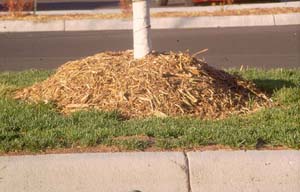 |
| Bad Practices: Classic Mulch Volcano (UMN.edu) |
Easy Does It
 |
| Too Much Mulch |
- Wood-boring insects living in the mulch can tunnel through to the softened, partially-decomposing bark and gain easy-access to the greenwood or vascular tissues beneath the bark, introducing vectors of disease.
- Diseases such as harmful fungal canker diseases (rots), bacterial attacks or virus diseases can more easily penetrate to the interior of the plant when the bark remains continually moist.
- Critters such as mice and meadow voles can tunnel through the mulch and chew through the outer bark to reach the tasty living inner bark. This will cut off the flow of water up from the roots and nutrients down from the leaves, causing the plant to die.
- Roots tend to migrate up toward the top of the mulch layer during rainiy periods, only to dry out when summer drought sets in.
In times of drought, such a thick "volcano" of mulch a foot high can prevent rainfall or irrigation water from reaching the root system in an "umbrella" system, causing additional plant stress.
LandscapExperts Recommendations
Mulch Ring Size
A mulch ring can be a radius about 2 to 3 feet out from the trunk, or can go all the way out to the canopy's drip line. This ring provides a protection zone for the roots as well as for the trunk.
Depth
Two to three inches of organic mulch is plenty, since thicker layers inhibit the exchange of oxygen between the tree roots and the atmosphere, since roots need air as well as water to remain healthy. Leave a space 2 - 3 inches between the bark and the beginning of the mulch for good air circulation.
Material
Compost, well-rotted wood chips and pine straw work well and contribute to the organic content of the soil as they break down over time. Crabapple LandscapExperts do not recommend rubber mulches or dyed mulches because of reduced air and moisture supply and the release of toxic chemicals. Neither should fresh wood chips or sawdust be used, since they temporarily rob the tree of nitrogen during the process of decomposition.
Contact your Crabapple Rep to discuss using proper mulch rings to highlight specimen trees and shrubs in the landscapes you manage.
Digging Deeper:
University of Georgia weighs in on Mulch Volcanoes:
http://apps.caes.uga.edu/urbanag/Home&Garden/indexFS.cfm?storyid=2710


No comments:
Post a Comment